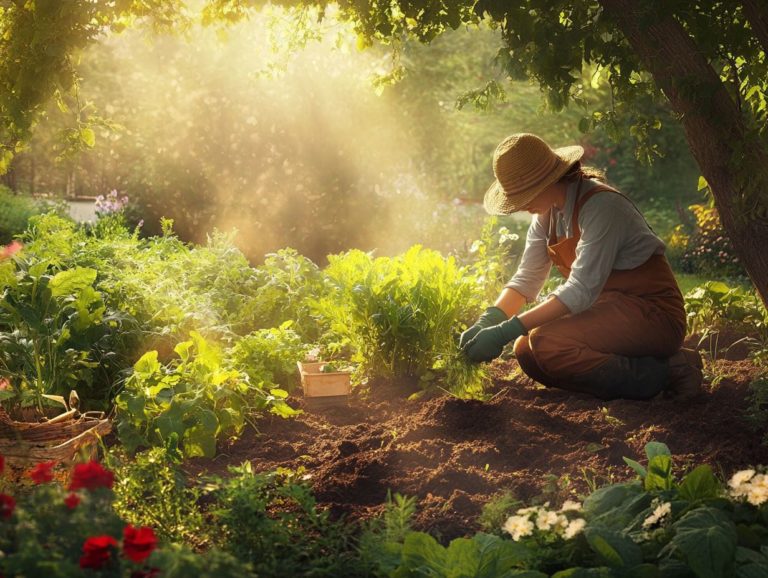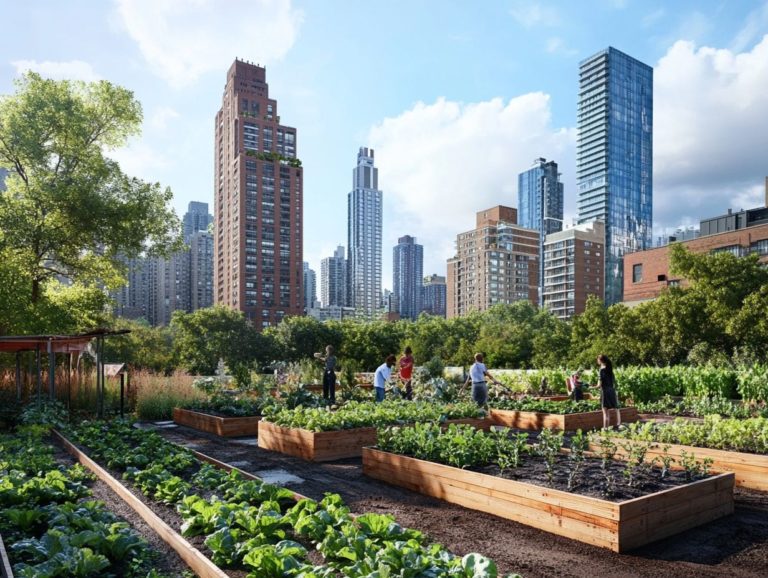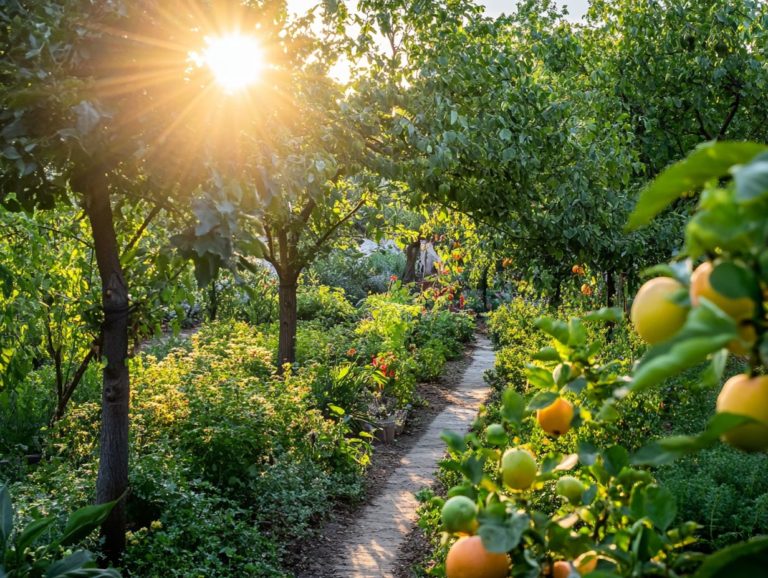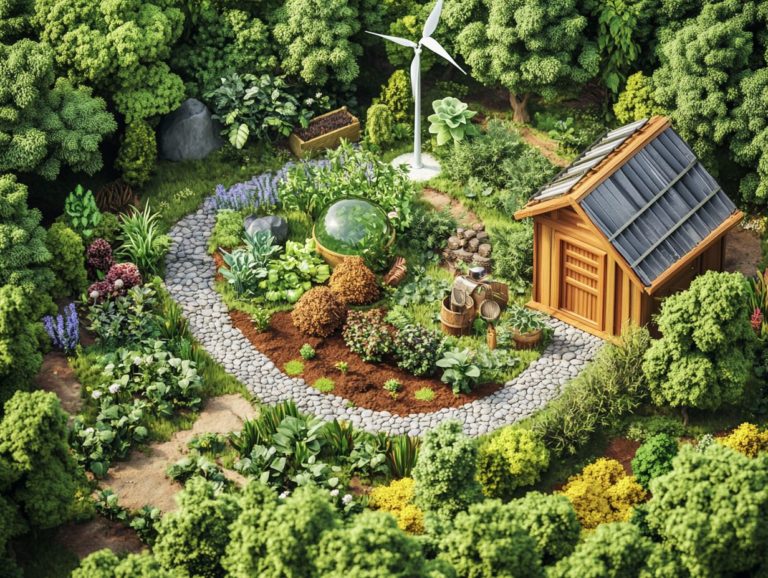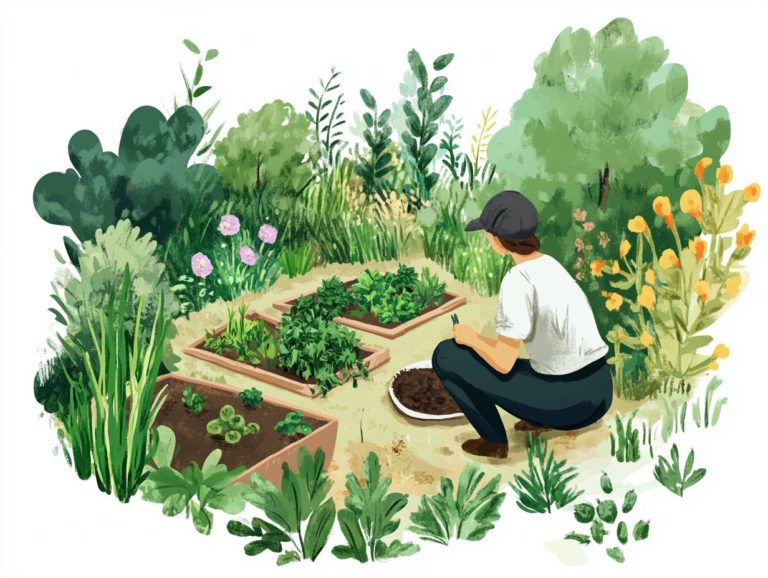10 Common Mistakes in Permaculture Design
Permaculture design presents a sustainable pathway to gardening and agriculture, yet even the most experienced practitioners can stumble upon familiar pitfalls.
This article delves into ten critical mistakes that may hinder your permaculture endeavors, ranging from ignoring local climate conditions to overlooking soil health and water management.
By recognizing these missteps, you ll gain the knowledge necessary to cultivate thriving, resilient ecosystems that not only enrich your garden but also contribute positively to your community-sufficiency and the environment.
Immerse yourself in this exploration of permaculture principles and discover how to refine your permaculture design for optimal success!
Contents
- Key Takeaways:
- 1. Not Considering the Local Climate and Environment
- 2. Not Planning for Proper Water Management
- 3. Lack of Diversity in Plant Selection
- 4. Not Incorporating Companion Planting
- 5. Not Utilizing Vertical Space
- 6. Not Incorporating Natural Pest Control Methods
- 7. Not Planning for Adequate Sunlight
- 8. Not Considering the Needs of the Community
- 9. Not Properly Planning for Soil Health
- 10. Not Considering the Long-Term Maintenance of the Design
- What Is Permaculture and Why Is It Important?
- Frequently Asked Questions
- 1. What are some common mistakes in permaculture design?
- 2. How important is it to consider climate in permaculture design?
- 3. Can using invasive plants be a mistake in permaculture design?
- 4. What is one mistake that can lead to pest problems in permaculture design?
- 5. Is it important to properly plan for water conservation in permaculture design?
- 6. How can I avoid making common mistakes in permaculture design?
Key Takeaways:
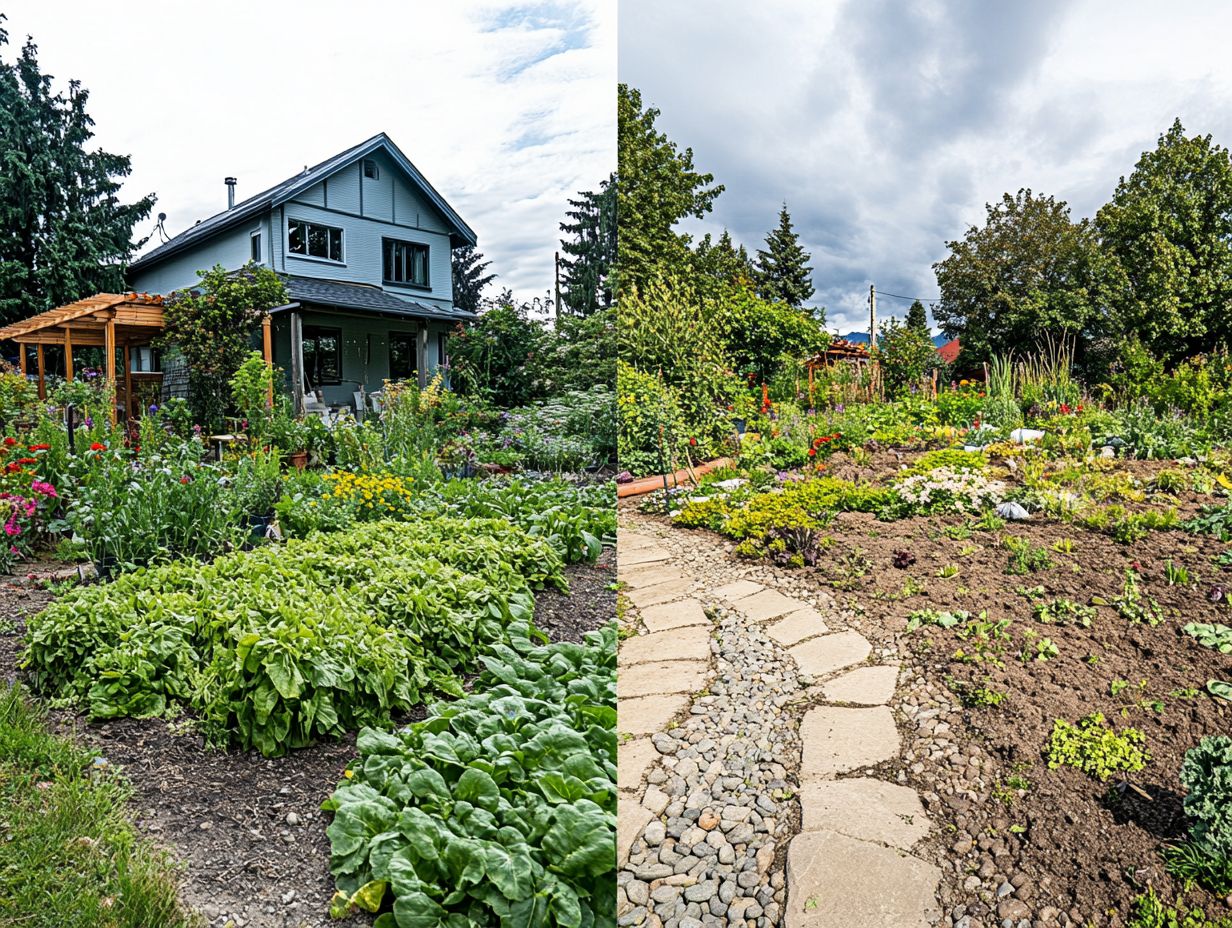
- Consider the magic of your local climate for successful permaculture design.
- Proper water management is crucial in permaculture, enhancing your design principles and sustainability.
- Diversity in plant selection and companion planting are key in permaculture design.
1. Not Considering the Local Climate and Environment
When you embark on your journey into permaculture design, one of the most critical oversights is neglecting to consider your local climate and environment. Understanding the 7 essential principles of permaculture design is fundamental for creating a thriving homestead.
By understanding the specific climatic conditions and natural resources available in your area, you can design a sustainable ecosystem that thrives on renewable resources while minimizing waste.
This approach resonates deeply with the teachings of Nicholas Burtner from the School of Permaculture and the foundational insights of Bill Mollison. Their work highlights how local environmental factors can significantly influence the success of your permaculture garden.
Temperature ranges, annual rainfall, and soil types are pivotal elements guiding your plant selection and overall design. Knowing whether your area faces droughts or heavy rainfall will help you determine which plants will flourish or struggle, impacting your productivity and sustainability.
The School of Permaculture offers essential education on these key elements, giving you the power to make informed decisions. Graduates have successfully designed rainwater harvesting systems tailored to local rainfall patterns or selected drought-resistant crops suited to their climates, embracing homestead planning for sustainable ecosystems.
These examples illustrate how grasping these nuances can lead to thriving, sustainable landscapes.
2. Not Planning for Proper Water Management
Effective water management is essential in permaculture design, yet many homesteaders often overlook this vital aspect. This oversight can lead to unsustainable practices that compromise soil health and disrupt ecosystem balance.
By planning for water conservation techniques such as swales, rainwater harvesting, and well-designed drainage systems you can create a closed loop within your homestead that optimizes the use of renewable resources.
This proactive strategy strengthens the resilience of your permaculture system and reduces the risks associated with water scarcity and food shortages.
Integrating techniques like greywater systems and keyline design can elevate soil vitality and promote biodiversity. These methods conserve valuable water while enhancing nutrient cycling by returning organic matter back into the soil.
As seasons evolve, adapting these systems to accommodate varying rainfall patterns becomes crucial. This adaptation allows for efficient moisture retention and erosion prevention.
Engaging with your community in collective water management efforts fosters a sense of shared responsibility. It highlights the necessity for emergency preparedness, ensuring local ecosystems thrive and establishing a sustainable framework that benefits everyone involved.
3. Lack of Diversity in Plant Selection
A common misstep in permaculture design is overlooking the importance of plant diversity. For a more successful approach, consider the key components of a successful permaculture design, as this can leave your ecosystem vulnerable and weaken its resilience to pests and diseases.
By embracing diverse planting strategies and incorporating companion planting principles, you can cultivate a more balanced and thriving ecosystem. This supports overall soil health and attracts beneficial insects, essential for the ecological activities within your homestead.
Fostering a rich variety of plant species will significantly contribute to your productivity and sustainability. Diverse plant selection serves more than just pest resistance; it enhances soil quality by engaging a variety of root systems that prevent erosion and enrich the nutrient profile.
For example, did you know that planting tomatoes with basil not only boosts flavor but also keeps harmful insects at bay? Similarly, growing different plants together, like legumes such as peas with corn, can fix nitrogen in the soil, benefiting both crops.
The significance of biodiversity is paramount. It fosters resilience against environmental changes and enhances pollination, ultimately leading to a more sustainable and productive homestead. By integrating these practices into your daily cultivation, you can achieve a healthier ecosystem that benefits all interconnected elements.
4. Not Incorporating Companion Planting
Companion planting is crucial in your permaculture design, yet it often slips under the radar. This leads to missed chances for natural pest control and improved plant vitality.
Pairing plants that help each other grow and keep pests away creates a more resilient landscape. This harmonious approach not only elevates the productivity of your garden but also reflects the fundamental principles of sustainable ecosystems.
Next, consider marigolds. When you plant them alongside tomatoes, they can effectively deter tiny roundworms and other pesky insects. Plus, basil not only enhances the flavor of tomatoes but also helps repel flies and mosquitoes.
Then there’s the classic trio of corn, beans, and squash, commonly called the Three Sisters. This combination fosters a mutually beneficial relationship that optimizes space and resources.
By embracing these practices, you re not just nurturing healthier plants; you re also moving toward a zero-waste homestead. This reduces your dependence on synthetic pesticides and fertilizers, encouraging the use of organic materials like compost.
Through thoughtful crop combinations, you can cultivate an ecosystem rich in biodiversity, promoting natural pest control and enhancing soil health leading to a garden that truly thrives in sustainability.
5. Not Utilizing Vertical Space
Imagine boosting your garden’s productivity by utilizing vertical space, an often overlooked aspect of permaculture design. By incorporating vertical gardens, trellises, and wall planters, you can maximize your growing area while maintaining an aesthetically pleasing landscape.
Optimizing your space helps both plant health and diversity. When you incorporate climbing plants like peas, cucumbers, and pole beans, you can dramatically increase your yield. These plants thrive on vertical structures, improving air circulation and sunlight exposure, which in turn promotes healthier growth.
The advantages go beyond aesthetics; this approach fosters a more diverse ecosystem by attracting pollinators and beneficial insects that play crucial roles in maintaining a thriving garden.
Ultimately, using vertical space in your garden can transform it into a lush, productive area while reducing waste. It gives you the power to craft abundant, food-producing landscapes that positively impact the environment.
6. Not Incorporating Natural Pest Control Methods
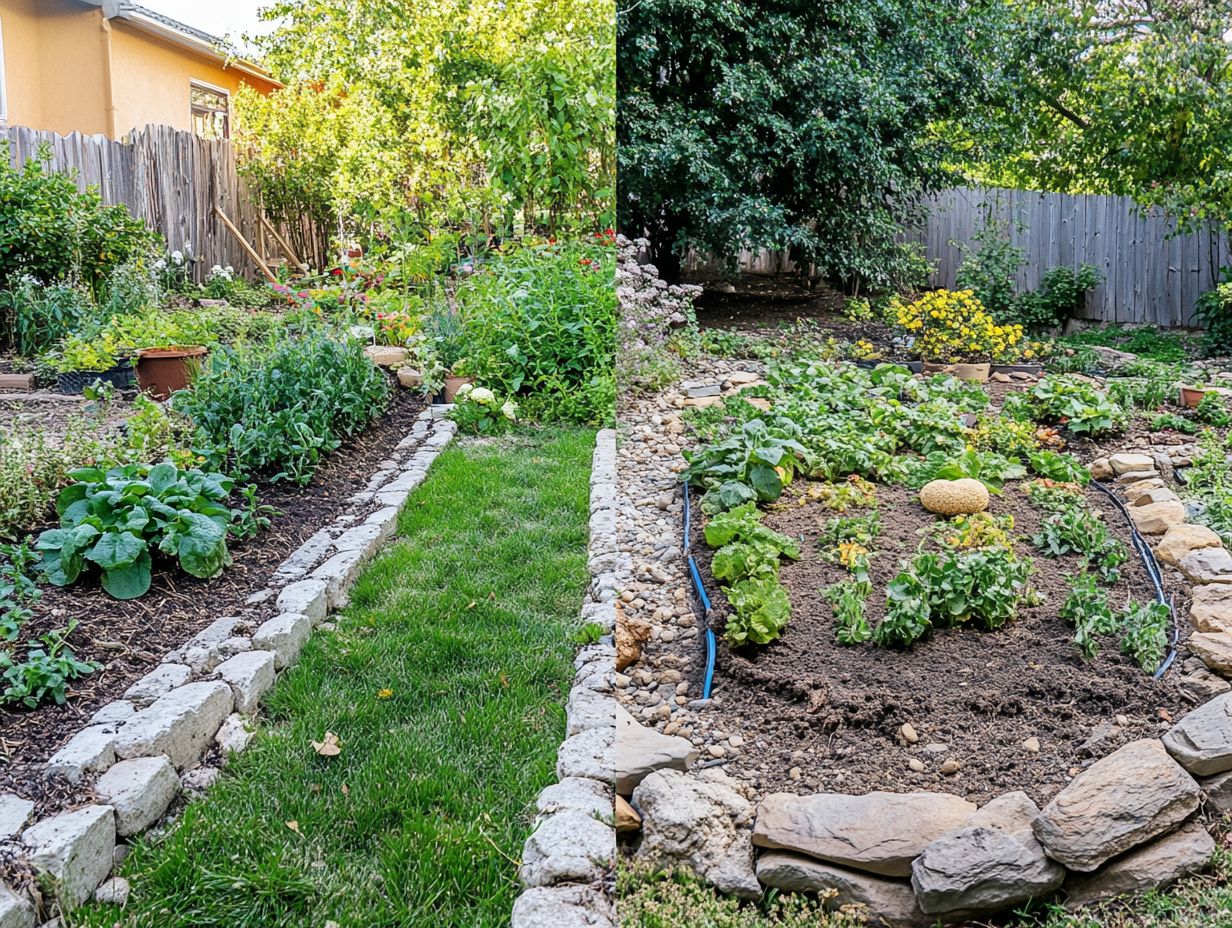
Pest control is essential in permaculture. Ignoring natural methods can lead to a reliance on chemicals that upset your homestead’s ecological balance.
Encourage beneficial insects like ladybugs and lacewings to create a self-regulating environment. Companion planting enhances this by pairing pest-repelling plants with those that attract their predators.
Using physical barriers like row covers protects your plants and promotes biodiversity. These methods streamline pest management and foster a self-sustaining ecosystem.
Ultimately, you’ll create a resilient and productive garden you can take pride in!
7. Not Planning for Adequate Sunlight
Planning for adequate sunlight is vital for your plants’ health and the overall success of your homestead. By understanding the sun’s path and its interactions with your landscape, you can place plants according to their light needs, ensuring your garden thrives.
This thoughtful planning optimizes energy storage within your ecosystem and enhances productivity, creating a more resilient and sustainable permaculture design.
To assess sunlight availability, observe how shadows change throughout the day. Identify areas that bask in full sun, enjoy partial shade, or dwell in deep shade. Different plants have unique light requirements some flourish in bright conditions, while others prefer gentle, dappled light.
When designing your garden layout, position taller plants on the northern side to avoid casting shadows on shorter ones. This promotes healthy growth all around. By maximizing sunlight exposure, your garden will yield fresh produce and support a zero-waste lifestyle.
8. Not Considering the Needs of the Community
Considering the needs of the community is a cornerstone principle of permaculture. It plays a crucial role in crafting a sustainable and resilient homestead. Aligning your design with local demands and resources allows you to cultivate community sufficiency and develop a thriving ecosystem.
This holistic approach addresses local food shortages and promotes renewable resource use while strengthening community bonds and shared knowledge.
Engaging with community members through collaborative projects can transform vacant spaces into vibrant gardens. Local organizations can offer essential support in the form of funding and expertise. By sharing resources such as tools, seeds, and labor permaculture initiatives foster a sense of ownership and responsibility among participants.
Educational workshops empower you with the skills needed to implement sustainable practices in your life, creating a ripple effect of positive change. This interconnectedness paves the way for a brighter, more sustainable future for everyone involved.
9. Not Properly Planning for Soil Health
Soil health serves as the bedrock of any successful permaculture design. Yet, many homesteaders overlook this crucial element, resulting in reduced productivity and ecological imbalance. By incorporating practices such as composting, cover cropping, and organic amendments, you can significantly enhance soil vitality. This fosters a thriving ecosystem that supports diverse planting and sustainable yields.
Focusing on soil health allows you to create a closed-loop system that nourishes your plants while bolstering the overall resilience of your homestead.
To nurture this critical component, it s essential to integrate organic matter through methods like leaf litter, kitchen scraps, or animal manure. These materials improve soil structure and stimulate vigorous microbial activity, which is vital for nutrient cycling.
Practices such as crop rotation and reduced tillage further enrich soil fertility and biodiversity, creating a stable environment for beneficial organisms.
Using nitrogen-fixing cover crops plants that naturally add nitrogen to the soil, essential for healthy growth can be a game-changer for your soil health. Applying worm castings breathes life into nutrient-depleted soils. These combined approaches not only prevent waste but also elevate the ecosystem’s overall health, leading to bountiful harvests and a resilient homestead.
10. Not Considering the Long-Term Maintenance of the Design
Neglecting the long-term maintenance of your permaculture design can set you up for unforeseen challenges that threaten the sustainability and resilience of your homestead. By weaving in principles of emergency preparedness and planning for seasonal shifts, you can craft a management strategy that supports the longevity of your ecological activities and fortifies your sustainable systems.
This foresight is crucial for maintaining the delicate balance of your permaculture design and achieving a truly zero-waste homestead.
A solid long-term plan should encompass scheduled care for both plants and animals while outlining a maintenance routine that anticipates variations in weather and potential disruptions.
By gaining a deep understanding of your local ecosystem and applying resource management techniques like composting and rainwater harvesting, you can significantly enhance the resilience of your garden.
Embracing proactive strategies, such as diversifying your crops and integrating companion planting growing different plants together to naturally support each other’s growth will help mitigate risks tied to food shortages. This ensures a steady supply even in the face of challenging climatic conditions.
Ultimately, this thoughtful preparation paves the way for adaptable systems that can flourish amidst ever-changing environmental landscapes.
What Is Permaculture and Why Is It Important?
Permaculture represents an innovative design philosophy that focuses on crafting sustainable ecosystems, mirroring the intricate processes found in nature. By embracing this approach, you cultivate a harmonious relationship between yourself and the environment.
It emphasizes the integration of renewable resources, community self-sufficiency, and ecological balance. This offers you a framework to thrive sustainably, whether as an individual or as part of a community. Visionaries like Nicholas Burtner from the School of Permaculture champion this philosophy, underscoring its potential to transform spaces into resilient homesteads while addressing pressing global issues like food shortages and environmental degradation.
By employing techniques that enhance biodiversity and regenerate land, you play a vital role in paving the way toward a more sustainable future. This philosophy is more important than ever, especially in our current climate, where urgent matters such as climate change and food insecurity demand immediate action.
Leading organizations, such as the Permaculture Institute and the Regenerative Agriculture Association, are at the forefront of this movement. They provide education and resources for aspiring practitioners like yourself. Through workshops and community outreach, these groups strive to empower individuals, fostering a culture of resilience and collaboration that equips communities to adapt to challenges and create healthier ecosystems for generations to come.
Start planning your permaculture garden today for a sustainable future!
How Can Proper Planning Lead to a Successful Permaculture Design?
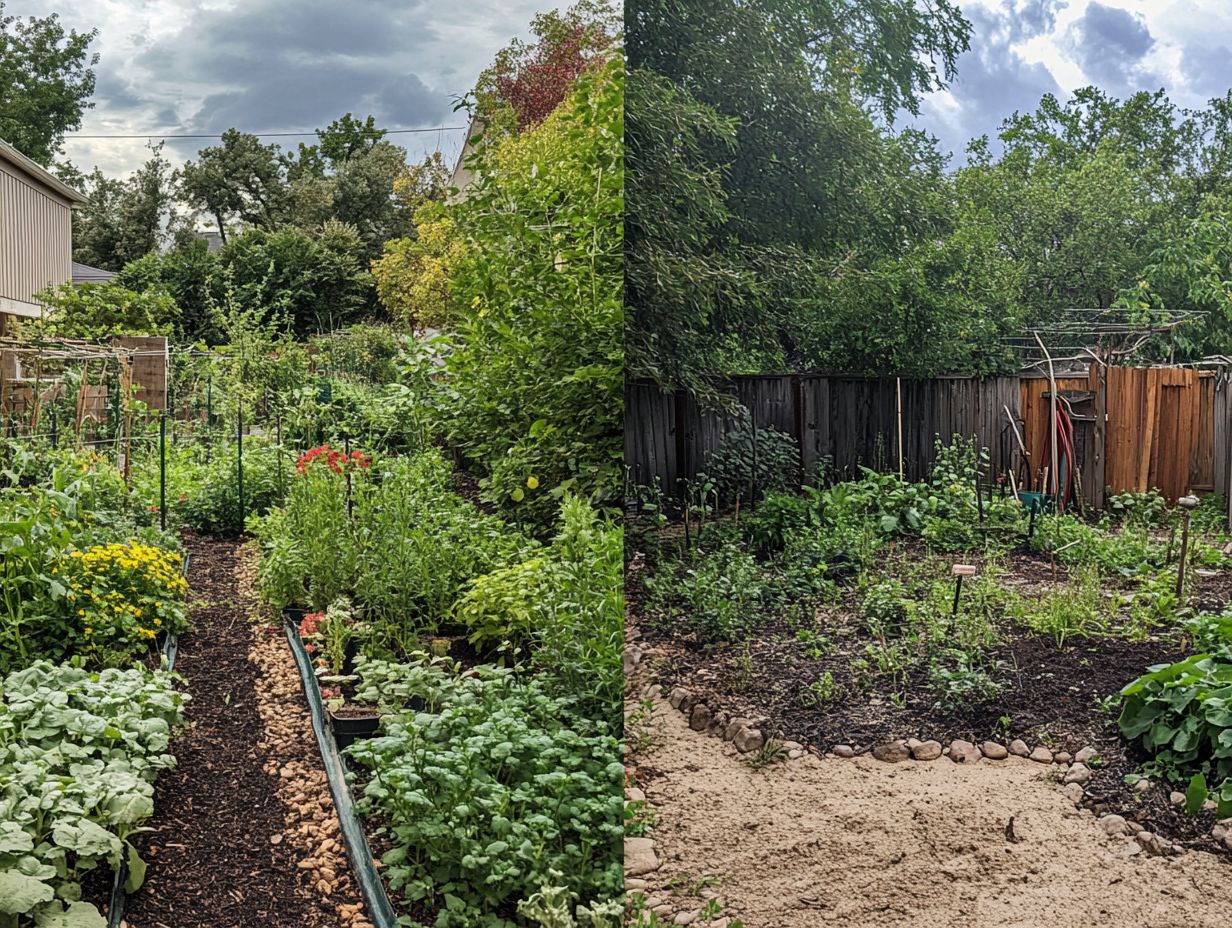
Proper planning serves as the bedrock of a successful permaculture design. It creates the framework for efficient and sustainable ecosystems that flourish over time. By thoughtfully considering factors such as site analysis, resource allocation, and energy storage, you can develop a holistic approach that maximizes the potential of your land. This foresight guarantees optimal resource use and cultivates resilience against changing environmental conditions, ultimately leading to a more sustainable lifestyle.
Conducting a thorough site assessment is essential. It involves analyzing soil quality, climate patterns, and existing vegetation, helping you pinpoint the unique opportunities and challenges presented by your landscape. Mapping out where your resources are is equally crucial, as it catalogs water sources, sunlight exposure, and wind patterns. This allows for effective placement of elements that enhance energy efficiency.
When it comes to landscape design, integrating diverse plant species and establishing microclimates can significantly boost biodiversity and yield. These strategies also foster a deeper connection between you and your environment, promoting stewardship and encouraging practices that support long-term ecological health.
What Are the Key Principles of Permaculture Design?
The key principles of permaculture design provide a robust framework for achieving ecological balance and fostering sustainable ecosystems that thrive in harmony with nature. These principles highlight the importance of working with natural processes, encouraging you to observe and interact with your environment while valuing the diversity of plants and resources. Grasping these concepts is crucial for anyone eager to implement effective permaculture practices in their homestead.
Take the principle of ‘Catch and Store Energy.’ Installing rainwater harvesting systems reduces reliance on municipal water and nourishes your gardens and landscapes. By integrating diverse plant species, you’ll not only bolster resilience against pests and diseases but also attract beneficial insect populations.
Imagine how you can transform your garden today. A backyard garden designed around these principles, featuring a mix of perennials and annuals, ensures year-round harvests and nurtures a richer ecosystem. Such designs reveal that permaculture transcends mere gardening; it’s about cultivating a sustainable lifestyle that honors and rejuvenates the natural world.
What Are the Benefits of Incorporating Permaculture into Agriculture?
Incorporating permaculture into your agricultural practices offers a wealth of benefits, including enhanced food security, community sufficiency, improved soil health, and increased biodiversity. By applying permaculture principles, you can create sustainable ecosystems that minimize waste and maximize resource efficiency. This results in healthier crops and a more resilient agricultural system. This holistic approach tackles modern farming challenges and supports the long-term sustainability of our food systems, promoting sustainable ecosystems.
One of the standout advantages of permaculture is its ability to reduce chemical use, benefiting both the environment and your health. For instance, a case study from a community in Brazil revealed that farmers who embraced permaculture techniques significantly decreased their reliance on synthetic pesticides. This led to a flourishing of beneficial insect populations, particularly through companion planting.
Permaculture cultivators often find themselves better equipped to adapt to the impacts of climate change, as diverse planting strategies can buffer against extreme weather events. The success of a permaculture project in Australia, especially near Melbourne, illustrates this perfectly. Farmers reported a remarkable 30% increase in crop yields during drought years, thanks to their diverse polyculture systems and effective water management. This not only enhanced nutritional diversity but also ensured a more stable food supply.
How Can Permaculture Help with Sustainable Living?
Permaculture plays a crucial role in promoting sustainable living by providing practical solutions that harness renewable resources and embrace a zero-waste homestead approach. By implementing the basic ideas of permaculture, you can cultivate self-sustaining ecosystems that reduce your reliance on external inputs and minimize your environmental impact. Ultimately, this leads to a zero-waste homestead. This lifestyle enhances your personal well-being while positively contributing to the health of our planet and strengthening local communities.
To seamlessly weave permaculture into your daily life, start with your waste management practices. Composting organic waste, like chicken feed, enriches your soil. It also keeps waste out of landfills.
Adopting water conservation methods like rainwater harvesting and efficient irrigation systems can significantly lower your water usage while nurturing your gardens.
Engaging with your neighbors to share resources such as tools or seeds cultivates a sense of community. It encourages collective responsibility for local ecosystems, fostering connections that help everyone learn from one another.
Start your vegetable garden today and enjoy fresh produce while connecting with your community! Utilizing homemade arnica oil and participating in local farmers’ markets deepens your connection with your surroundings while savoring the fruits of your labor sustainably.
What Are Some Common Myths About Permaculture?
Despite its rising popularity, several myths about permaculture continue to linger, leading to misconceptions about its practices and benefits. You might think permaculture is solely about gardening or that it requires vast expanses of land, overlooking the remarkable versatility and adaptability of its principles across various settings.
Understanding and dispelling these myths is essential for positioning permaculture as a viable solution for creating sustainable ecosystems, such as those practiced at the School of Permaculture.
In truth, permaculture embodies a holistic approach to design that seamlessly integrates agriculture, landscape, and community. It’s just as applicable in urban environments as it is on rural farms. The notion that you need extensive expertise to practice permaculture is also misleading. Even beginners can successfully implement its principles with a little education and a willingness to experiment. Resources like the Homestead Planning & Design Class or Mother Earth News Fair can help you get started.
The environmental impact of permaculture is often misunderstood, overshadowing its potential as a pathway for emergency preparedness against food shortages. Contrary to popular belief, studies reveal that permaculture practices enhance biodiversity and improve soil health. Engaging with Nicholas Burtner or exploring Rancho Mastital demonstrates how these methods contribute positively to the environment. Best of all, they can be scaled up or down to fit different contexts, making permaculture an accessible pathway for anyone looking to make a meaningful impact.
Frequently Asked Questions
1. What are some common mistakes in permaculture design?
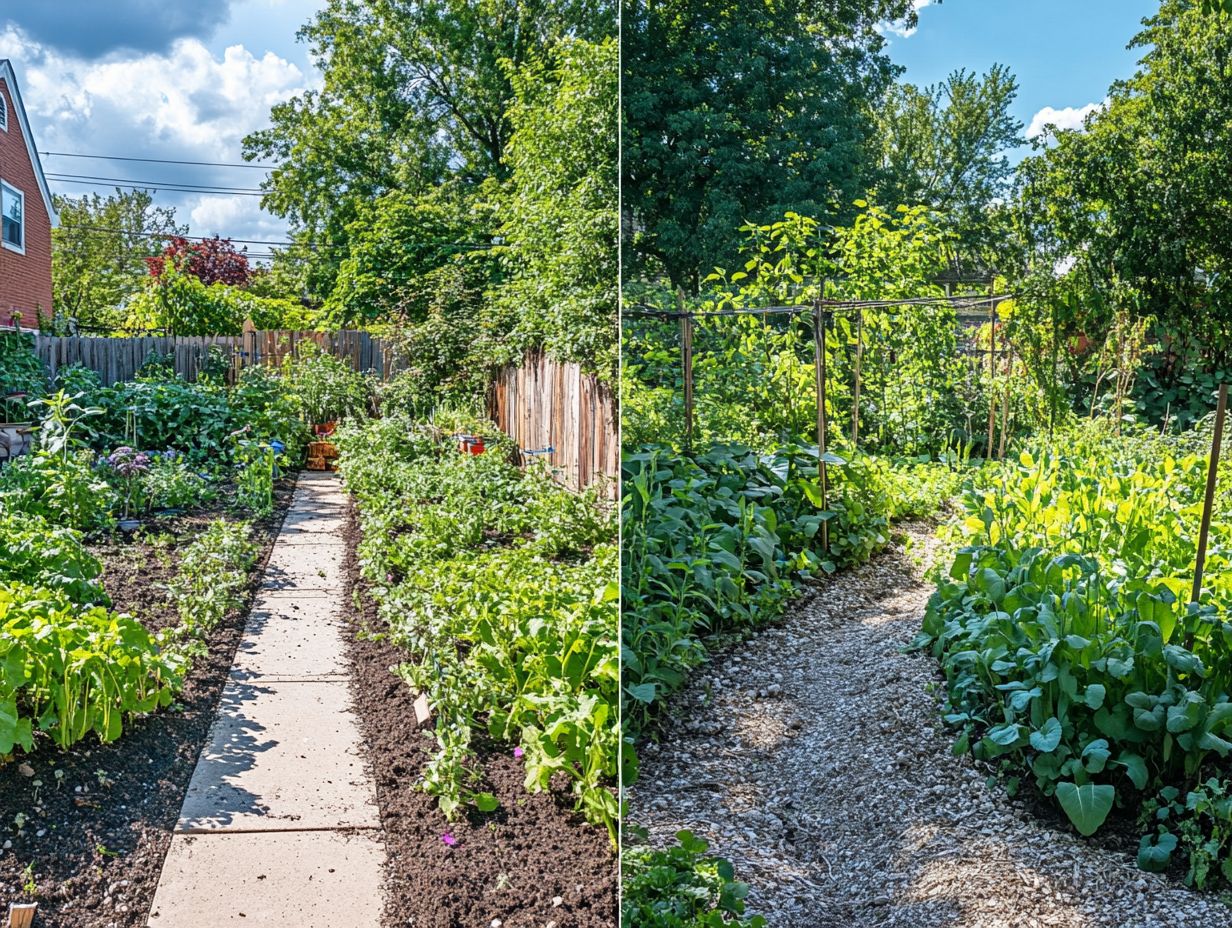
Some common mistakes in permaculture design include not considering the climate and specific needs of the site. Others include using invasive or non-native plants and not properly planning for pest control. To avoid these pitfalls, explore 7 ways to enhance your permaculture design, as it’s crucial to pay attention to the importance of observe and interact techniques.
2. How important is it to consider climate in permaculture design?
Considering the climate is essential in permaculture design. It helps determine which plants will thrive, what methods of irrigation and water management to use, and other important factors for successful permaculture.
3. Can using invasive plants be a mistake in permaculture design?
Yes, using invasive plants in permaculture design can harm the ecosystem. They can quickly overtake native plants, causing imbalances in the environment and directly impacting soil health.
4. What is one mistake that can lead to pest problems in permaculture design?
Not planning ahead to manage pests can lead to issues in permaculture design. Relying solely on conventional methods ignores effective natural solutions.
5. Is it important to properly plan for water conservation in permaculture design?
Planning for water conservation is essential for thriving plants. This helps minimize water waste and ensures plants receive the right amount of water, especially through methods like closed circles, which create a cycle of water reuse.
6. How can I avoid making common mistakes in permaculture design?
The best way to avoid common mistakes is to do thorough research. Seek guidance from experienced permaculturists like Bill Mollison and Nicholas Burtner, and dive into learning by following the 7 steps to effective permaculture design as you adapt your approach.

